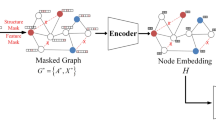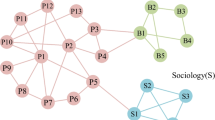Abstract
Community detection and link prediction are two basic tasks of complex network system analysis, which are widely used in the detection of telecom fraud organizations and recommendation systems in the real world. In ordinary unsigned networks, these two analyses have been developed for a long time. However, due to the existence of negative edges, the study of community detection and link prediction in signed networks is still limited now. Most existing methods have high computational complexity and ignore the generation of the networks based on heuristics. In this paper, we propose a regularized convex nonnegative matrix factorization model (RC-NMF) from the perspective of the generative model to detection communities in the signed network. This algorithm introduces graph regularization to constrain nodes with negative edges into different communities and nodes with positive edges into the same communities as much as possible. Experiments on synthetic signed networks and several real-world signed networks validate the effectiveness and accuracy of the proposed approach both in community detection and link prediction.








Similar content being viewed by others
References
Amelio A, Pizzuti C (2016) An evolutionary and local refinement approach for community detection in signed networks. Int J Artif Intell Tools 25(04):1650021
Anchuri P, Magdon-Ismail M (2012) Communities and balance in signed networks: a spectral approach. In: Proceedings of the 2012 international conference on advances in social networks analysis and mining (ASONAM 2012), IEEE Computer Society, pp 235–242
Cartwright D, Harary F (1956) Structural balance: a generalization of heider’s theory. Psychol Rev 63(5):277
Chen Y, Wang X, Yuan B, Tang B (2014) Overlapping community detection in networks with positive and negative links. J Stat Mech Theory Exp 3:P03021
Chiang KY, Hsieh CJ, Natarajan N, Dhillon IS, Tewari A (2014) Prediction and clustering in signed networks: a local to global perspective. J Mach Learn Res 15(1):1177–1213
Davis JA (1967) Clustering and structural balance in graphs. Hum Relat 20(2):181–187
Derr T, Wang Z, Dacon J, Tang J (2020) Link and interaction polarity predictions in signed networks. Soc Netw Anal Min 10
Ferligoj A, Kramberger A (1996) An analysis of the slovene parliamentary parties network. Dev Stat Methodol 12:209–216
Ghoshal G, Mangioni G, Menezes R, Poncela-Casanovas J (2014) Social system as complex networks. Soc Netw Anal Min 4(1)
Harary Frank (1953) On the notion of balance of a signed graph. Mich Math J 2(2):143–146
Heider F (1946) Attitudes and cognitive organization. J Psychol 21(1):107–112
Jiang JQ (2015) Stochastic block model and exploratory analysis in signed networks. Phys Rev E 91:062805
Jiao P, Yu W, Wang W, Li X, Sun Y (2018) Exploring temporal community structure and constant evolutionary pattern hiding in dynamic networks. Neurocomputing 314:224–233
Jordan MI (2009) Convex and semi-nonnegative matrix factorizations. IEEE Trans Pattern Anal Mach Intell 32(1):45–55
Kulakowski K, Stojkow M, Zuchowska-Skiba D (2019) Heider balance, prejudices and size effect. J Math Sociol 1–9
Kumar S, Hooi B, Makhija D, Kumar M, Faloutsos C, Subrahmanian V (2018) Rev2: fraudulent user prediction in rating platforms. In: Proceedings of the eleventh ACM international conference on web search and data mining, ACM, pp 333–341
Lancichinetti A, Fortunato S, Radicchi F (2008) Benchmark graphs for testing community detection algorithms. Phys Rev E Stat Nonlinear Soft Matter Phys 78(4 Pt 2):046110
Leskovec J, Huttenlocher D, Kleinberg J (2010) Signed networks in social media. In: Proceedings of the SIGCHI conference on human factors in computing systems, ACM, pp 1361–1370
Li X, Fang H, Zhang J (2018a) File: a novel framework for predicting social status in signed networks. In: Thirty-second AAAI conference on artificial intelligence
Li Y, Liu J, Liu C (2014) A comparative analysis of evolutionary and memetic algorithms for community detection from signed social networks. Soft Comput 18(2):329–348
Li Z, Chen J, Fu Y, Hu G, Pan Z, Zhang L (2018b) Community detection based on regularized semi-nonnegative matrix tri-factorization in signed networks. Mob Netw Appl 23(1):71–79
Maniu S, Abdessalem T, Cautis B (2011) Casting a web of trust over wikipedia: an interaction-based approach. In: Proceedings of the 20th international conference companion on world wide web, ACM, pp 87–88
Newman M (2016) Community detection in networks: Modularity optimization and maximum likelihood are equivalent. arXiv preprint arXiv:160602319
Read KE (1954) Cultures of the central highlands, new guinea. Southwest J Anthropol 10(1):1–43
Rossi RA, Ahmed NK (2019) Complex networks are structurally distinguishable by domain. Soc Netw Anal Min
Song D, Meyer DA (2015) Recommending positive links in signed social networks by optimizing a generalized auc. In: Twenty-ninth AAAI conference on artificial intelligence
Vasudevan M, Deo N (2012) Efficient community identification in complex networks. Soc Netw Anal Min 2(4):345–359
Wang H, Zhang F, Hou M, Xie X, Guo M, Liu Q (2018) Shine: signed heterogeneous information network embedding for sentiment link prediction. In: Proceedings of the eleventh ACM international conference on web search and data mining, ACM, pp 592–600
Wang S, Aggarwal C, Tang J, Liu H (2017) Attributed signed network embedding. In: Proceedings of the 2017 ACM on conference on information and knowledge management, ACM, pp 137–146
Yang B, Cheung W, Liu J (2007) Community mining from signed social networks. IEEE Trans Knowl Data Eng 19(10):1333–1348
Yang B, Liu X, Li Y, Zhao X (2017) Stochastic blockmodeling and variational bayes learning for signed network analysis. IEEE Trans Knowl Data Eng 29(9):2026–2039
Zhao X, Yang B, Liu X, Chen H (2017) Statistical inference for community detection in signed networks. Phys Rev E 95:042313
Zheng Q, Skillicorn DB (2015) Spectral embedding of signed networks. In: Proceedings of the 2015 SIAM international conference on data mining, SIAM, pp 55–63
Author information
Authors and Affiliations
Corresponding author
Additional information
Publisher's Note
Springer Nature remains neutral with regard to jurisdictional claims in published maps and institutional affiliations.
Rights and permissions
About this article
Cite this article
Wang, J., Mu, R. A Regularized Convex Nonnegative Matrix Factorization Model for signed network analysis. Soc. Netw. Anal. Min. 11, 7 (2021). https://doi.org/10.1007/s13278-020-00711-1
Received:
Revised:
Accepted:
Published:
DOI: https://doi.org/10.1007/s13278-020-00711-1




